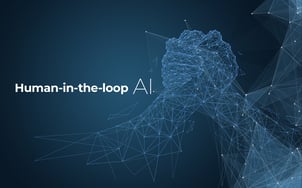Artificial Intelligence (AI) is becoming increasingly prevalent today, with its applications being used in various fields such as manufacturing, healthcare, finance, and transportation. One of the most significant ways in which AI is being used is in decision-making processes. As data becomes more readily available, AI algorithms can process and analyze it quickly, making accurate predictions and decisions. However, there is a growing concern that AI may make decisions that are not in the best interest of humans. To address this concern, there is a growing trend toward the use of a “Human in the Loop” approach for augmented decision-making.
 The Human in the Loop (HITL) approach involves incorporating human input and oversight into the decision-making process. This approach allows for a balance between the accuracy and efficiency of AI algorithms and the ethical and moral considerations that are essential for decision-making. It ensures that the decisions made by AI align with the values and interests of humans, making it a more responsible and trustworthy technology.
The Human in the Loop (HITL) approach involves incorporating human input and oversight into the decision-making process. This approach allows for a balance between the accuracy and efficiency of AI algorithms and the ethical and moral considerations that are essential for decision-making. It ensures that the decisions made by AI align with the values and interests of humans, making it a more responsible and trustworthy technology.
For example, AI systems can be designed to flag decisions that are likely to be controversial or deviate significantly from past decisions. These flagged decisions can then be reviewed by human experts, who can use their own judgment to decide whether the AI's decision is correct or not.
Another way to incorporate human input into the AI decision-making process is by using explainable AI (XAI). XAI is a type of AI designed to be transparent and explainable, making it easier for humans to understand how the system arrived at its decision. This can be done using techniques such as feature visualization, decision trees, and rule-based explanations.
One of the key benefits of the Human in the Loop (HITL) approach is that it allows for greater transparency in decision-making. With human input, the reasoning behind decisions made by AI can be easily understood and explained. This is particularly important in fields such as healthcare, where decisions have a direct impact on human lives.
 In a study by the American Medical Association, it was found that 84% of patients want their doctors to use AI in decision-making, but also want to know how the AI came to its conclusions. The Human in the Loop approach combined with XAI allows for this transparency, giving patients and healthcare providers peace of mind and building trust in the technology.
In a study by the American Medical Association, it was found that 84% of patients want their doctors to use AI in decision-making, but also want to know how the AI came to its conclusions. The Human in the Loop approach combined with XAI allows for this transparency, giving patients and healthcare providers peace of mind and building trust in the technology.
We can’t negate the fact that humans can consider context, moral and ethical considerations, and other factors that may not be captured in the data-based algorithms. By incorporating human input, the AI can make more accurate and reliable decisions that consider all relevant factors.
The Human in the Loop (HITL) approach also allows for greater accountability and responsibility in decision-making. With human input, there is a transparent chain of responsibility for decisions made by AI. This is particularly important in finance and transportation industries, where decisions can have significant financial and safety implications. In a study by the World Economic Forum, it was found that 72% of executives believe that AI will increase accountability and transparency in decision-making.
 In the coming years, the use of AI in decision-making is expected to grow exponentially. According to a report by Gartner, by 2024, AI will be responsible for more than 50% of decision-making. The Human in the Loop (HITL) approach will become increasingly significant as AI is used in more critical and sensitive areas such as defense and finance. We must continue to invest in and develop the Human in the Loop (HITL) approach to ensure that AI is used responsibly and in the best interest of humans.
In the coming years, the use of AI in decision-making is expected to grow exponentially. According to a report by Gartner, by 2024, AI will be responsible for more than 50% of decision-making. The Human in the Loop (HITL) approach will become increasingly significant as AI is used in more critical and sensitive areas such as defense and finance. We must continue to invest in and develop the Human in the Loop (HITL) approach to ensure that AI is used responsibly and in the best interest of humans.
In conclusion, the Human in the Loop approach for augmented decision-making is a crucial step in ensuring that AI is responsible, transparent, and trustworthy. As AI continues to be integrated into various fields, the HITL approach must be implemented to ensure that the technology is used in the best interest of society and the communities, it serves.

